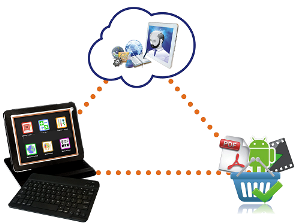There is recent advancement in computer and technology, the education system seems more organized and systemic than before. Considering this aspect, one can simply predict a more technology-based classroom environment that would benefit both the teachers and students in future. Smartphones and Tablets have reinforced this ideology further by introducing innovative ideas and concepts in the traditional ways of schooling. At the present students can learn in a more flexible and self-paced environment without any difficulty with resources like time, people, space and money. This has resulted in a well-organized and faster way to learn and grow within a particular field of study. Here we will inform you about some important benefits that you be able to avail using Tablets, Smartphones and other mobile devices in classroom. Here they are-
Mobility-

iPads or Tablets and Smartphones are compact gadgets that offer learning on the go. Inside a classroom, teachers can make use of these machines to demonstrate points, present information throughout projectors or even conduct lectures through video conference. This ultimately facilitates students with learning process as they can attend lessons, participate in class activities or still take notes without the constraints of space and time. Similarly, these tools may help students communicate on lessons or queries while they are away from the classroom. For example, Smartphone can come handy for a student to participate in several classroom activities through Skype while he cannot physically attend the classroom.
Versatility-
Tablets and Smartphones are machines that can be used for a variety of purposes by students. They are handy tools for studying online, taking notes, and still attending real-time classroom activities. In the same way, they can be used for multitasking. Learning tools like calculator, dictionary and periodic give handy support to students in various learning activities. As well, Smartphone has built-in educational applications that further improve the learning experience. In android-based operating system, you can use MS Office tool to create, modify or delete any documents at the same time as a Picasa tool can be used to save important images for projects. This promotes proficient learning by speeding up the whole learning procedure.
Noise Free-
Different from a PC, an iPad and Smartphone provide noise-free learning environment. Because these devices offer touch-screen option, there is no requiring connecting keyboard or mouse. This results in a learning environment that reduces noise and increases focus in the classroom.
Interactivity-

Learning throughout audio/video mediums improves the overall learning experience. Moreover, it helps students learn in an interactive way. Both Tablet and Smartphone are rich resources of audio/visual tools, for instance charts, graphs and images. With this learning experience, visual elements become more engaging and fun for students that ultimately promote them to learn and grow.
Furthermore, a Tablet and Smartphone is an effective tool while it comes to learning different activities of a task. Both of gizmos can be used for sharing how to videos and animation. For instance, teachers can use 3D simulation to demonstrate dead areas under sea-level for a class on Marine Biology or students can visit an archaeological site throughout a video-sharing website for studying Ancient Civilization. Likewise, a Science teacher can perform a live lab experiment as students watch it in their classes.
Flexibility-
Using a variety of Apps allow students to learn in an adaptable environment. Using Start Walk, the students of science studies can now watch live activities in galaxies or perform a chemical reaction using a ReactionMate, an app in the iPhone. So students can at the present avail from a more flexible and adaptable way of learning.
Social Media Networking-
Tablets and Smartphones are efficient tools to communicate through social-media websites. They allow students to act together with fellow students and share knowledge, news and videos concerning a project. Using social media platforms also allows students to instantly get answers or feedback from their teachers, seniors and fellow students for any issues. With popular social media websites, for example Facebook, Twitter and Pinterest, students are showing to a more diversified form of knowledge.